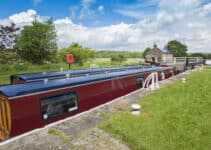Water is vital to narrowboaters and canal boaters, for many different reasons. Along with most other humans on the planet, boaters need water to drink, bathe, wash and even add ballast to their boats! If you are a canal boater, you have water all around you in the canal system, so it is natural that you may start dreaming up ways to use this canal water on your boat. But is canal water safe? Are there ways to utilise it on a canal or narrowboat? This is the question we hope to answer today!
Is Raw UK Canal Water Safe to Drink?
The simple answer is no. The obvious reason would be that there are industries that exist along the British canals and may be dumping potentially toxic materials in canal waters. Also, think about all of the farms that exist alongside our canals and could be unwillingly washing all kinds of industrial farming materials into the canal waters. Animals such as rats also use our canals and could be leaving behind urine and other potentially harmful elements for humans. Finally, think of all the grey water from boats that is dumped into the canal system. Although not as big an issue as some of the others, it is certainly worth consideration. And when you add all these factors up, in leads to canal water that is not drinkable.
If you do drink raw UK canal water, you could be at risk from some of these health issues:
Leptospirosis (Weil’s disease)
This is a disease that is caused by coming into contact with the urine of animals such as rats or cows (that are already infected with the disease). Any water that is relatively stagnant and is positioned near farm animals or is visited by a large amount of rodents could be at risk.
Gastro-intestinal illness
Gastrointestinal illness, also referred to as Gastroenteritis, is an infection of the gastrointestinal tract, the organ system that includes the stomach and intestines. It is usually caused by a virus or bacteria. If there are high concentrations of certain bacteria or viruses in the canal water, you could fall ill to this illness if you drink the water. Although it is not usually life threatening, it could lead to uncomfortable symptoms such as diarrhea and vomiting.
Blue-Green algae – Cyanobacteria
Blue-green algae, also called Cyanobacteria, are a type of bacteria that live in water. They are an ancient life form. They were among the first bacteria to produce oxygen by photosynthesis, billions of years ago. Cyanobacteria can produce toxins that are harmful to plants, animals, and humans. People who come into contact with cyanobacteria may have skin rashes, hay fever, and breathing problems.
Is Raw UK Canal Water Safe for Anything?
Frankly, I wouldn’t recommend raw UK canal water for anything other than flushing your toilet. The potential harmful bacteria, viruses and commercial chemicals that could be in the canal water make it unusable for anything else (in my opinion).
Are There Ways to Make UK Canal Water Useable on a Canal Boat?
There have been some very creative people recently that have tried to filter the canal water to use it in different ways. The main one I have seen is from the YouTube channel ‘Alan Denman’ who have vlogging about all things canal boat for a while now. In the video below they proudly show us their new narrowboat based water filtration system, that is designed mainly so that they can have an endless supply of bath water. Although they do also mention in this video that this system could possibly be good to produce drinking water, something which I think is somewhat alarming. Yes, they have an excellent filtration system that would take out most particle based problems, but they need something to get rid of other bacteria. A UV light sterilisation process could work for this, but is not present in this system.
Would I Use Filtered Canal Water?
My take on this is that this system could be great for shower, bath or washing water. However, I wouldn’t want to use this water for drinking water for several reasons. Firstly, unless you can add a UV filter, I simply wouldn’t be confident drinking this water. It would be fine for survival needs but not for drinking daily. Problems can build up over time if you haven’t got your filtration system spot on, and I personally wouldn’t want to take that risk. If you do want to go down the route of drinking this water, I would make sure to send the water off to be tested by an official lab. This would be expensive but would provide the ultimate peace of mind that the water is safe to drink.
The other reason I don’t want to drink canal water is that you are effectively taking this water out of the system (as black water cannot go back in the canals). Many canals already suffer from low water levels and if this idea of drinking canal water caught on, I think it would lead to severe water level problems.
Having said all of this, I think the water from this filtration system would work great in tandem alongside a regular water supply from a water tank. You could use the water tank on your narrowboat as your source of drinking water (filled from the water points along the canal), and use the filtered canal water to take baths, showers and to do your washing. As grey water is put back into the canals, you are not taking anything away from them. And your water tank would last for a much longer time if you are only using it for drinking water.
Don’t forget that this water filtering system is expensive, though. The one detailed in the video cost approximately £2000 (and this is without a UV filter). Add to this the considerable cost of replacing the multiple filters in the system on a regular basis, and you have something that is pretty costly. This should only be a solution for those that are really struggling with their regular water supply right now and value their baths and showers enough to invest this amount of money in them!
What Would You Do?
As always, I like to make these articles into a community affair. I would love to know your thoughts on the whole filtered canal water debate in the comments section below 🙂



![What Happened to Cruising The Cut [Narrowboat Youtuber]](https://canalboatuk.com/wp-content/uploads/2022/08/cruising-the-cut-youtube-channel-211x150.png)
